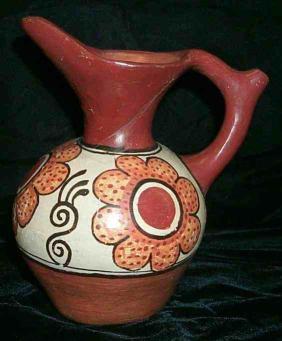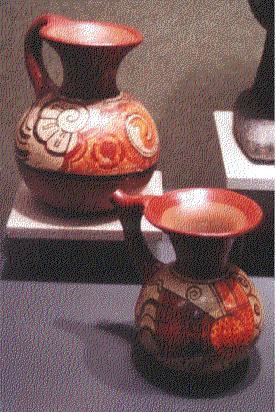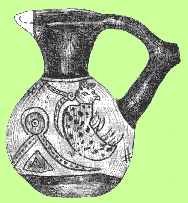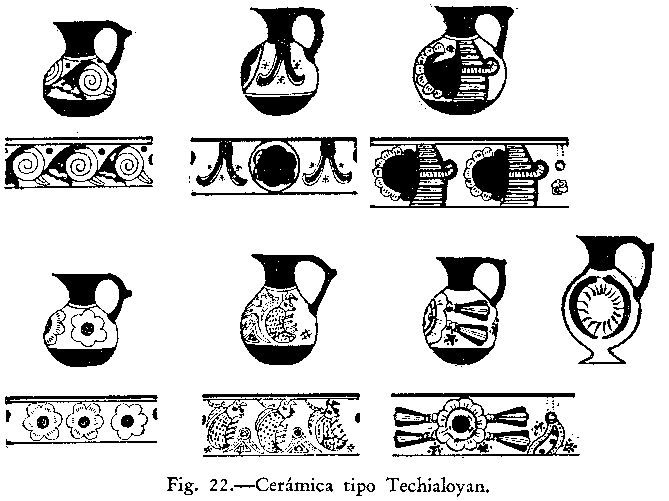Postclassic Ceramics of the Toluca Valley:
"Techialoyan Style" Polychrome Pitchers

This page describes examples of an unusual style of polychrome pitcher
from the Postclassic Toluca Valley. José García Payón
called this style "Techialoyan" after a town in the Toluca area. It is
not clear why he chose that name, since the vessels are found in a number
of sites in the Toluca Valley. There is little resemblance between the
designs on these vessels and the seventeenth-century Techialoyan Codices
from the area (see bibliography below). The designs are more elaborate
and naturalistic than most Postclassic central Mexican polychromes, and
they contrast with the strongly geometric style of the Postclassic polychrome
bowls, plates, and jars of the Toluca Valley. These pitchers could date
to the early post-conquest period, but they do not closely resemble any
known Early Colonial ceramics from central Mexico.
The pitcher at the right is from the Bauer collection at the American
Museum of Natural History in New York, NY (reproduced with permission).
It is catalog no. TV1-079 in my catalog of Toluca Valley Postclassic ceramic
vessels. For information on the Bauer collection, see my article "Postclassic
Ceramics from the Toluca Valley in US Museums: The Bauer and Blake Collections"
in Mexicon, vol. 23 (6): 141-146,

The pitchers at the left are on display in the Museo Nacional de
Antropología in Mexico City. They are from the Late Postclassic
site of Tizatlan in Tlaxcala. They share the style of decoration with the
pitchers from the Toluca Valley, and the one in front shares the hollow
handle with an opening. A similar style is found on at least one Postclassic
bowl from the site of Zultepec in Tlaxcala (Martínez Vargas, Enrique
and Ana María Jarquín Pacheco (1998) Materiales arqueológicas
del noroeste de Tlaxcala. Instituto Nacional de Antrpología
e Historia, Mexico City).
Until more examples are reported and studied, it is not possible
to say if all of these pots were traded from a single center of production
of whether this was a style more widely distributed with separate local
production centers.

The other examples here are drawings from García Payón's
article on ceramics from the Toluca Valley
García Payón, José
1941 La cerámica del Valle de Toluca. Revista Mexicana
de Estudios Antropológicos 5(2-3):209-238.
I would appreciate input from anyone with any insights or suggestions
on this style of decoration. Is it most likely Postclassic or Colonial
in date? I am leaning toward the former possibility, but right now that
is
only a hypothesis.

Bibliography on Techialoyan Codices:
Harvey, Herbert R.
1986 Techialoyan Codices: Seventeenth Century Indian Land
Titles in Central Mexico. In Ethnohistory, edited by Ronald Spores, pp.
153-164. Handbook of Middle American Indians, Supplement. Vol. 4. University
of Texas Press, Austin.
Noguez, Xavier
1999 Códice Techialoyan de San Pedro Tototepec (Estado
de México). El Colegio Mexiquense, Toluca.
1999 Los códices del grupo Techialoyan. Arqueología
Mexicana 7(38):38-43.
Noguez, Xavier and Rosaura Hernández Rodríguez
1992 Códice Techialoyan García Granados. El
Colegio Mexiquense, Toluca.
Robertson, Donale
1975 Techialoyan Manuscripts and Paintings, With a Catalog.
In Guide to Ethnohistorical Sources, part 3, edited by Howard F. Cline,
pp. 253-280. Handbook of Middle American Indians. Vol. 14. University of
Texas Press, Austin.
Wood, Stephanie
1989 Don Diego García de Mendoza Moctezuma: A Techialoyan
Mastermind? Estudios de Cultura Náhuatl 19:245-268.
Back to Matlatzinco
Home Page
This page was produced by Dr. Michael E. Smith, Professor
of Anthropology, University at Albany, State University of New York.
 To
go to Michael E. Smith's home page, Click
Here.
To
go to Michael E. Smith's home page, Click
Here.
© 2002, Michael E. Smith (revised 4/10/02)




 To
go to Michael E. Smith's home page,
To
go to Michael E. Smith's home page,